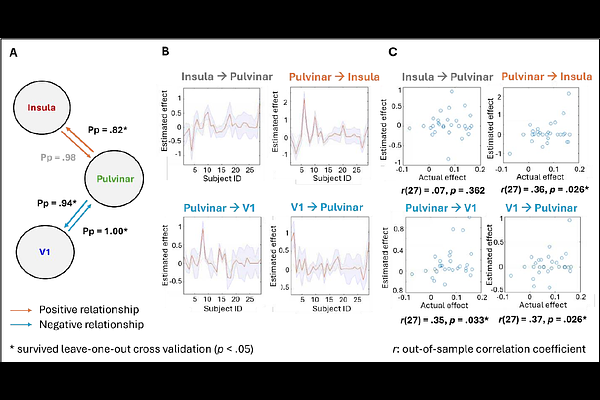Effective connectivity reveals dual-route mechanism of visual prediction precision via insula and pulvinar

Effective connectivity reveals dual-route mechanism of visual prediction precision via insula and pulvinar
Tao, L.; Steward, T.; Corbett, J.; Glarin, R. K.; Sava, T. V.; Garrido, M. I.
AbstractThe brain\'s ability to weight predictions by their precision is a central mechanism in predictive processing, enabling optimal integration of prior expectations with incoming sensory input. Despite its theoretical significance, the neural circuitry that implements precision-weighted prediction remains unclear. Using 7-Tesla fMRI and dynamic causal modelling (DCM), this study investigated how the brain encodes the precision of predictions during a visual cueing task with high- and low-precision conditions. We focused on the key regions implicated in predictive processing: the insular cortex, the pulvinar nucleus of the thalamus, and primary visual cortex (V1). Behaviourally, participants showed significantly greater accuracy in the high-precision condition (p < .001), confirming effective task manipulation. DCM analyses revealed that high-precision predictions elicited excitatory modulation of connectivity from the insula to V1 (Pp = .95), alongside inhibitory influences from the insula to the pulvinar (Pp = .99) and from the pulvinar to V1 (Pp = .89). Furthermore, leave-one-out cross validation revealed that individual differences in behavioural sensitivity to precision were positively predicted by pulvinar-to-insula connectivity (r = .36, p = .026) and negatively predicted by the connectivity between pulvinar and V1 (pulvinar to V1: r = .35, p = .033; V1 to pulvinar: r = .37, p = .026), highlighting the behavioural relevance of these pathways. Together, these findings suggest a dual-route mechanism whereby the insula directly enhances top-down predictions in V1 while indirectly dampening bottom-up sensory input via the pulvinar. This mechanism may facilitate Bayesian integration under uncertainty and offers new hypotheses into how precision weighting may be disrupted in neuropsychiatric conditions.